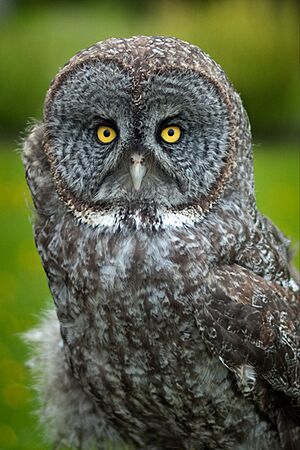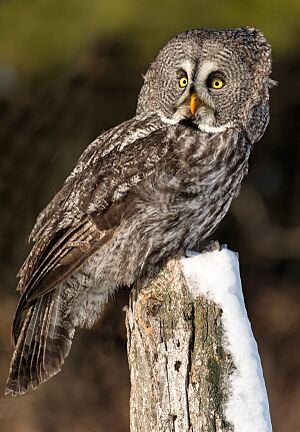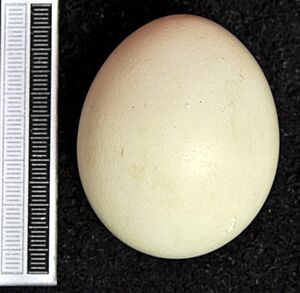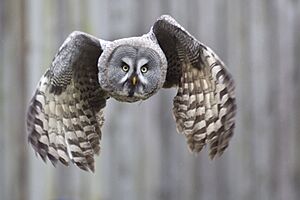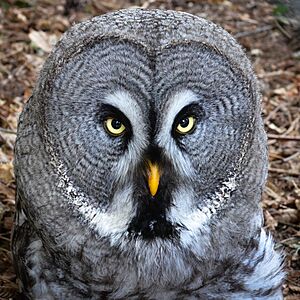Great grey owl facts for kids
Quick facts for kids Great grey owl |
|
|---|---|
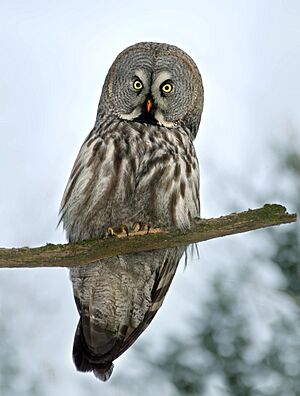 |
|
| Strix nebulosa | |
| Conservation status | |
| Scientific classification | |
| Genus: |
Strix
|
| Species: |
nebulosa
|
The great grey owl (Strix nebulosa) is a very large owl. It is known as the world's longest owl. You can find this owl across the Northern Hemisphere. It's the only owl from its group (the Strix genus) that lives in both the Eastern and Western parts of the world. People sometimes call it the Phantom of the North or the Lapland owl.
Contents
About the Great Grey Owl
Great grey owls have big, round heads with grey faces. Their eyes are yellow with darker circles around them. Their chests are light with dark stripes, and their backs are grey with lighter stripes. These owls don't have ear tufts. They have the largest facial disc of any raptor. A white patch, like a "bow-tie," sits just below their beak. Their long tail gets narrower towards a rounded end.
The great grey owl is thought to be the longest owl in the world. It is longer than the Eurasian eagle-owl and the Blakiston's fish owl. However, these other owls weigh more. Much of the great grey owl's size comes from its fluffy feathers and large head. Its body is actually lighter than many other big owls.
These owls are usually about 61 to 84 centimeters (24 to 33 inches) long. Females average 72 cm (28 in), and males average 67 cm (26 in). Their wingspan can be over 152 cm (5 feet), but it usually averages around 142 cm (56 in) for females and 140 cm (55 in) for males. Adult owls weigh between 580 and 1900 grams (1.3 to 4.2 pounds). Females average 1290 g (2.8 lb), and males average 1000 g (2.2 lb). Like most owls, males are usually smaller than females.
The adult owl's call is a deep, rhythmic series of 'who' sounds. They usually make these calls to mark their territory or talk to their young. Most of the time, adult owls are quiet. Young owls might chatter, shriek, or hiss. If humans feed tame owls, they might make higher-pitched hoots.
Owl Types: Subspecies
There are two types of great grey owls, called subspecies. They live across North America and Eurasia.
- S. n. nebulosa: This type lives in North America. You can find it from central Alaska across Canada to Quebec. It also lives south to northern California, Idaho, Montana, Wyoming, and Minnesota.
- S. n. lapponica: This type lives in northern Eurasia. It ranges from Scandinavia through Siberia to Sakhalin and Kamchatka. It also lives in Lithuania, Lake Baikal, Kazakhstan, Mongolia, and northern China.
Where Great Grey Owls Live
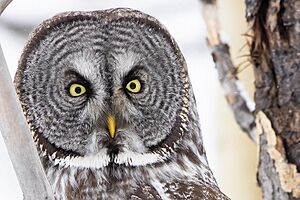
In northern areas, great grey owls often build their nests in thick conifer forests. These forests are usually near open spaces like meadows or bogs. In Oregon and California, these owls have been found nesting in mixed oak woodlands. People once thought these birds needed a cold climate. But now we know they can live in places where summer temperatures go above 38 degrees Celsius (100 degrees Fahrenheit).
Owl Range and Movement
Great grey owls breed in North America from Quebec to the Pacific coast and Alaska. They also breed from Finland and Estonia across northern Asia. They usually stay in the same area all year. However, owls from northern regions might move south when food is hard to find. In Europe, they breed in Norway, Sweden, Finland, and Russia. The first great grey owl known to science was found in Canada in the late 1700s.
Some great grey owl groups live permanently in California, Oregon, and Washington. In these states, the owls are found in separate areas that have the right habitat. In winter, these birds don't move far. But they might go to lower elevations to avoid deep snow. This is because they need to catch their prey on the ground.
In Oregon, great grey owls breed in scattered areas. These areas range from the Siskiyou Mountains in the southwest to the Blue Mountains in the northeast. Two bird festivals in May offer trips to try and see these owls.
A study in California in 2015 estimated that fewer than 300 great grey owls lived there. This species is listed as Endangered in California. The California range includes a small part of the Oregon population, north of Alturas. Owls have also been found nesting in the Tahoe National Forest and the Sierra Nevada foothills. The first nest south of Canada was found in Yosemite in 1914. A study there showed that the Yosemite owls have been separate from other owl groups for over 25,000 years.
In Washington state, great grey owls live in the southeast mountains and the Colville National Forest. Only a few great grey owl nests have ever been found in Washington.
Further east in the western United States, great grey owls breed in Idaho, Montana, and Wyoming. They can be found as far south as Grand Teton National Park and Yellowstone National Park.
In northeastern North America, these owls live all year in southern Quebec and Ontario. But sometimes, in winter, they move south into New York and New England. They do this to find more food. Great grey owls are rarely seen as far south as Pennsylvania and Long Island, New York. In winter 2017, owls were seen in northern New York and central Maine.
Great Grey Owl Reproduction
Great grey owls do not build their own nests. Instead, they usually use old nests made by other large birds, like raptors. They might also nest in broken tree tops or holes in big trees. In parts of Oregon, great grey owls have been using man-made platforms for nests since the 1980s. People started building these platforms for them in central Canada in the 1970s.
Nesting can happen from March to May. Unlike some birds, great grey owls don't always use the same nest site every year. They usually lay about four eggs. The eggs are about 42.7 mm (1.7 in) wide and 53.5 mm (2.1 in) long. The mother owl sits on the eggs for about 30 days, but it can range from 28 to 36 days. She stays with the young for 2 to 3 weeks after they hatch. Then, she starts resting on a nearby tree.
The young owls jump or fall from the nest when they are 3 to 4 weeks old. They start to fly 1 to 2 weeks after that. Right after leaving the nest, the fuzzy white young owls use their beaks and feet to climb back into trees. The female owl guards them closely at this time. She can be aggressive towards anything that might harm her young. Most young owls stay near their birth area for many months after they learn to fly.
Usually, the male owl hunts for his mate and the young throughout the nesting period. Once the young start to fly, the female often leaves them. The male continues to feed the young until they can hunt on their own in the autumn. The young owls leave their parents by winter.
The amount of food in an area usually affects how many eggs a female lays. This is common for owls in northern regions. In years when there are very few small mammals, great grey owls might not even try to nest. So, their breeding is linked to how many small mammals are available. Also, great grey owls might not nest in years with droughts. If food is scarce, they might travel far to find more prey. Sometimes, many owls move a long distance when prey is very scarce. Even though they don't migrate, many are at least a little bit nomadic, meaning they move around.
One person in northeast Oregon, Andy Huber, helped a female great grey owl raise her four babies. This happened after a great horned owl killed the male parent. Huber caught small mammals and released them near the nest. The female owl took these to her babies. As the young owls grew and started flying, they came for the prey themselves. Thanks to Huber and the mother owl, all four young owls grew up successfully.
How Great Grey Owls Find Food
These birds wait, listen, and watch for prey. Then, they swoop down to catch it. They might also fly low over open areas looking for food. They often hunt from a low spot where they can listen, like a tree stump, a low branch, a fence post, or a road sign. Their large facial discs, which are like big ruffs of feathers around their face, help them focus sounds. Their ears are placed unevenly on their head, which helps them find prey. This is very useful because they hunt when there isn't much light, like late in the evening or early in the morning. When they are nesting, they mainly hunt at night and around dawn and dusk. At other times, they are mostly active at night.
Great grey owls have amazing hearing. They can find and catch prey moving under 60 centimeters (2 feet) of snow just by listening. They can then crash through snow as deep as their own body size to grab their prey. Only great grey owls, and sometimes other large Strix owls, are known to "snow-plunge" for prey. This skill needs excellent hearing that not all owls have.
Unlike other owls that eat many different things, great grey owls mostly eat small rodents. What they eat depends on which small mammals are most common. In northern Canada and parts of Scandinavia, they mainly eat lemmings. In dry areas of California's Sierra Nevada, they mostly eat pocket gophers. In some places, voles are their main food. They also sometimes eat other animals (usually less than 20% of their diet). These can include squirrels, hares, moles, shrews, weasels, small birds like thrushes and grouse, small hawks, ducks, frogs, and large beetles. These owls do not usually scavenge (eat dead animals) or steal food from other predators. When a pair is nesting, the male is the main hunter. He provides food for the whole family while the female guards the eggs and young.
Threats to Great Grey Owls
Cutting down trees in the great grey owl's habitat is one of the biggest dangers to this species. When forests are managed for timber, it often means fewer large, old trees. These trees are important for nesting. Also, fewer leaning trees are left for young owls to rest on before they can fly. Dense tree cover, which young owls use for protection, is also reduced. If there are no places to perch in clear-cut areas, great grey owls cannot easily hunt there. Even though these owls use man-made nesting platforms, they are much more common in areas where logging is not allowed. Livestock grazing in meadows also harms great grey owls. It reduces the habitat for the small animals they like to eat.
Other dangers to great grey owls include poisons used to kill rodents, crashes with cars, and the West Nile Virus. The West Nile virus might become more common as the climate changes. In Ontario and northeast Oregon, some great grey owls have died from this virus. Testing of owls in the Yosemite area since 2005 has shown that the virus is present in that group of owls.
Because they are so large, great grey owls have few natural enemies. Great horned owls, some small meat-eating animals, and black bears have been seen eating young owls. But these predators rarely threaten adult owls. Owls have even been known to fight off animals as big as black bears when protecting their nests. The only known predator of adult great grey owls is the Eurasian eagle-owl (Bubo bubo). This owl sometimes hunts great grey owls in parts of Europe.
Owl Behavior
The great grey owl is not as aggressive as most other top predators. They are less likely to attack each other or potential threats than other large birds of prey. They do not protect a large nesting area, nor do they defend their hunting grounds aggressively. However, the female owl is aggressive when protecting her eggs and young. She is especially watchful and aggressive when the young owls first leave the nest but cannot fly yet, as they are very vulnerable then.
Because they are not very aggressive about their territory, great grey owls are hard to find in the wild. Most owls will respond to calls of their own species if played back in their nesting area. Great grey owls often ignore such calls. They also don't fly away every time a human comes near or drives past. The great grey owl often stays still even if a human is nearby. This is why they are often missed or not noticed.
Provincial Bird
The great grey owl is the official provincial bird of Manitoba, Canada.
Great Grey Owls in Captivity
As of 2016, there are four great grey owls living in captivity in Oregon and California. Two live at Blue Mountain Wildlife near Pendleton, Oregon. A third lives at Lindsay Museum in Walnut Creek, California. The fourth lives at CuriOdyssey in San Mateo, California.
An injured wild great grey owl named Boris lives at the Alaska Raptor Center in Sitka, Alaska. Boris was found north of Anchorage with an injury to his right wing, which means he cannot fly.
Another injured wild great grey owl, Errol, lives at the Alaska Zoo in Anchorage, Alaska. Errol came to the zoo after hurting himself when he hit the tire of a parked car.
The Eurasian type of the great grey owl is very commonly kept in zoos across Europe.
Great Grey Owls in Art
A great grey owl with human hands is shown on the album cover for The Magnolia Electric Co.. This is a 2003 album by Songs: Ohia.




